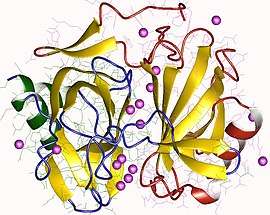Phosphoribosyl-AMP cyclohydrolase
In enzymology, a phosphoribosyl-AMP cyclohydrolase (EC 3.5.4.19) is an enzyme that catalyzes the chemical reaction
- 1-(5-phosphoribosyl)-AMP + H2O 1-(5-phosphoribosyl)-5-[(5- phosphoribosylamino)methylideneamino]imidazole-4-carboxamide
| phosphoribosyl-AMP cyclohydrolase | |||||||||
|---|---|---|---|---|---|---|---|---|---|
 phosphoribosyl-AMP cyclohydrolase dimer, Methanobacterium | |||||||||
| Identifiers | |||||||||
| EC number | 3.5.4.19 | ||||||||
| CAS number | 37289-22-8 | ||||||||
| Databases | |||||||||
| IntEnz | IntEnz view | ||||||||
| BRENDA | BRENDA entry | ||||||||
| ExPASy | NiceZyme view | ||||||||
| KEGG | KEGG entry | ||||||||
| MetaCyc | metabolic pathway | ||||||||
| PRIAM | profile | ||||||||
| PDB structures | RCSB PDB PDBe PDBsum | ||||||||
| Gene Ontology | AmiGO / QuickGO | ||||||||
| |||||||||
Thus, the two substrates of this enzyme are 1-(5-phosphoribosyl)-AMP and H2O, whereas its two products are [[1-(5-phosphoribosyl)-5-[(5-]] and [[phosphoribosylamino)methylideneamino]imidazole-4-carboxamide]].
This enzyme belongs to the family of hydrolases, those acting on carbon-nitrogen bonds other than peptide bonds, specifically in cyclic amidines. The systematic name of this enzyme class is 1-(5-phospho-D-ribosyl)-AMP 1,6-hydrolase. Other names in common use include PRAMP-cyclohydrolase, and phosphoribosyladenosine monophosphate cyclohydrolase. This enzyme participates in histidine metabolism.
Structural studies
As of late 2007, only one structure has been solved for this class of enzymes, with the PDB accession code 1ZPS.
References
- Minson AC, Creaser EH (1969). "Purification of a trifunctional enzyme, catalysing three steps of the histidine pathway, from Neurospora crassa". Biochem. J. 114 (1): 49–56. doi:10.1042/bj1140049. PMC 1184794. PMID 4309307.